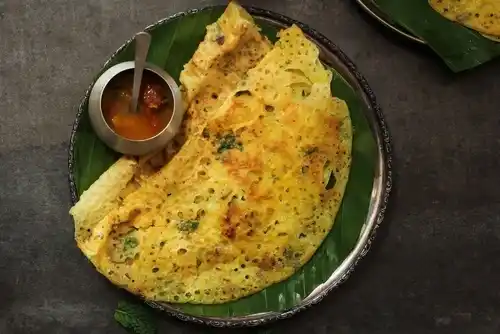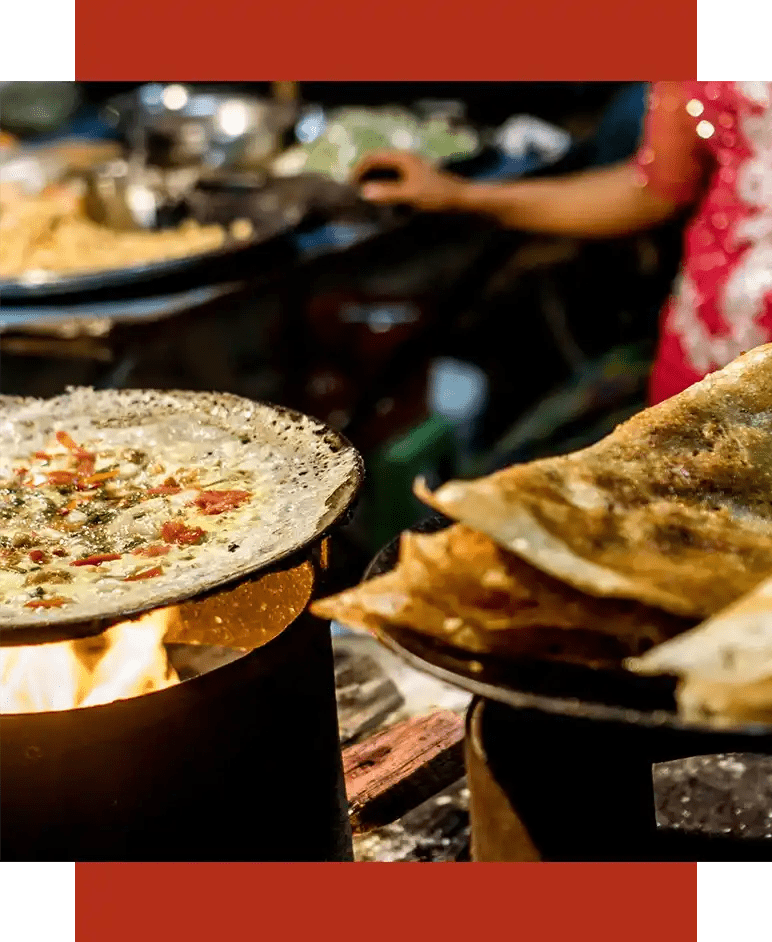Whenever I am in India I eat dosa whenever I can. I love dosa rolled up and very crispy – the kind that you can break with your fingers.
Indian cuisine delights with a variety of flavors and aromas, and one of its most characteristic dishes is dosa - a thin, crispy pancake made from fermented rice and lentil dough. This dish comes from southern India, where it is an everyday breakfast classic, but has gained popularity all over the world. Thanks to its lightness, crunchiness and richness of additives, dosa is an excellent proposition for both lovers of exotic flavors and people looking for healthy alternatives in the kitchen.

DOSA - History and Origin
Dosa has a long and rich history, dating back thousands of years. It was first mentioned in ancient Sanskrit texts and is believed to have originated in Tamil Nadu. Over the years, dosa spread to other South Indian states like Karnataka, Kerala and Andhra Pradesh, where local variations were created. Initially prepared as a simple dish for pilgrims and monks, it quickly became an integral part of Indian street food and home cooking.
Types of dosa
One of the greatest things about dosa is its versatility. While the classic version is the most common, there are many variations that vary in taste, texture, and serving.
- Masala dosa – one of the most popular versions, containing a filling of potatoes seasoned with curry, onion and spices. Often served with coconut chutney and sambar.
- Plain dosa – plain, without filling, but crispy and light. Perfect for dipping in various sauces and dips.
- Rava dosa – made with semolina instead of fermented rice dough. It is thinner and crispier, and its preparation does not require a long wait.
- Mysore dosa – a spicier variety in which the pancake is spread with hot chili sauce before adding the filling.
- Neer dosa – a more delicate and softer version, prepared with thin rice dough, typical of Karnataka cuisine.
Ingredients and preparation
The basic ingredients for dosa are very simple: rice, urad dal, water and a pinch of salt. The key step in the preparation is fermentation, which not only gives the batter a slightly sour taste but also makes the dosa easier to digest.
How to make dosa step by step?
- Soaking the ingredients – Soak the rice and urad dal separately for about 6 hours, then grind them until they form a smooth, slightly pourable dough.
- Fermentation – We leave the dough overnight in a warm place. Fermentation makes it fluffier and gives it a slightly sour aroma.
- Frying – Heat a pan, grease it with a thin layer of oil and spread a thin layer of dough, creating a round pancake. Fry on medium heat until golden and crispy.
- Serving – We can serve dosa with various additions like sambar, coconut chutney or ghee.
Additions and methods of administration
Dosa tastes delicious on its own, but it's the additions that make it a culinary treat. In India, it's usually served with:
- Sambar – a spicy, thick soup of lentils, vegetables and tamarind.
- Coconut chutney – a creamy, slightly sweet addition based on coconut, green chilies and cashew nuts.
- Tomato or mint chutney – refreshing sauces that give the dosa an additional flavor accent.
- Ghee – a bit of clarified butter on hot dosa highlights its unique flavour.
Why is it worth trying dosa?
Dosa is not only a tasty dish, but also a healthy one. Thanks to fermentation, it is easily digestible and rich in probiotics that support intestinal flora. In addition, it is naturally gluten-free and can be adapted to various diets - both vegan and high-protein. It is a great alternative to traditional pancakes and an ideal suggestion for breakfast or a light dinner.
Dosa can be eaten by people on a gluten-free diet because the dough is made of black urid lentils and rice flour. Frying on a flat, heated baking sheet adds crunchiness. In fact, only in India do I come across crispy dosas. I don't think any Indian restaurant in Warsaw makes them like this, which is a shame. Plain dosa, or the pancake itself, is usually served with a variety of chutneys - from spicy to sweet. Usually, coconut, mint, tamarind or tomato chutneys are served. They are white, green and orange - like the Indian flag. Now that's culinary patriotism
In one restaurant in Delhi, the dosa served to me was about a metre long
If you are in Delhi I can recommend Saravana Bhavan restaurant on Janpath Road. Very affordable prices, looks like a cheap bar but they serve great dosa and other Indian delicacies.
Or maybe you've already had a chance to try dosa? Share your impressions in the comments.






